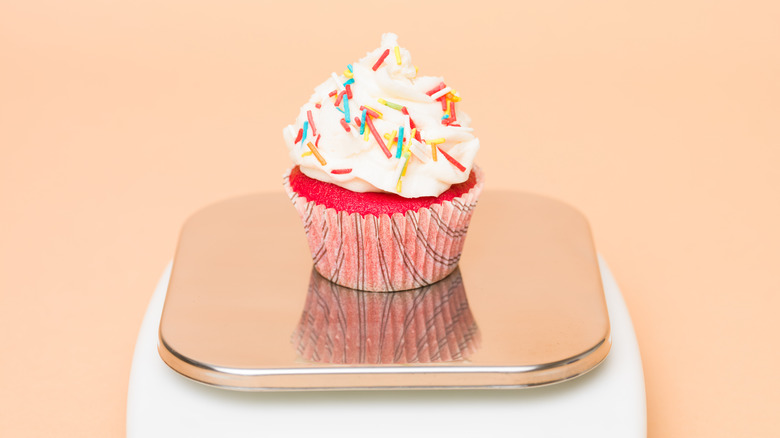Bake Perfectly Portioned Cupcakes With A Kitchen Scale Technique
Whether you're whipping up sweet treats for a bake sale or simply want to satisfy sugar cravings, cupcakes are hard to beat. Compact and portable thanks to their delicate paper thin liner, the scrumptious single-serving desserts are an easy way to have some cake without having to spend the whole day baking one. Plus, as if they weren't convenient enough, it's even possible to prepare a small batch of cupcakes in an air fryer — no oven required.
But no matter how you choose to cook cupcakes, portioning them evenly is where the true difficulty lies. Any baker worth their weight in flour knows how tricky it can be to fill a cupcake liner to the optimal level — let alone to repeat the process perfectly until you run out of batter. Fortunately, there's a must-have baking tool that can simplify this step while satisfying any perfectionist tendencies: a digital kitchen scale.
When baking cupcakes, set aside measuring cups and ice cream scoops in favor of a scale. Instead of struggling to pour the same amount of batter into each liner by eyeing it, place them on a kitchen scale one at a time and measure out each dessert by weight before placing them in a muffin tin. You can also weigh your batter to check exactly how much to reserve for each treat. Set an empty mixing bowl on the scale to zero it out, then take its total weight with the added batter and divide it by your number of cupcakes. The result? Perfectly portioned cupcakes.
Why using weight measurements is best for baking
From cups to tablespoons, chances are that anyone who has ever read a recipe has come across recommended measurements in volume. But whether they're working with a recipe for classic carrot cupcakes or a luxuriously rich chocolate cake, most pastry chefs prefer to measure their ingredients by weight instead. After all, this approach isn't only good for portioning batter, but almost all parts of baking. There are a few reasons why a scale is a baker's best friend, from avoiding additional dirty dishes to the universal use of grams in recipes. But the most important one comes down to precision — perhaps one of the biggest keys to baking successfully, as the whole affair concerns combining specific ratios of ingredients to achieve particular results.
Portioning out ingredients by weight is a surefire way to achieve accurate measurements. As it turns out, volume isn't always reliable, as it can be skewed by empty space. Take, for instance, flour — something that's in all kinds of baked goods, including cupcakes. A single cupful of the powdered stuff won't always weigh the same, as a range of factors from humidity to storage can affect how compact it is. When packed tight, a measuring cup can hold as much as 160 grams of flour; when fluffed, you might end up with closer to 120 grams. But when measured on a scale, the weight of flour — or any other ingredient — will always be exact.

